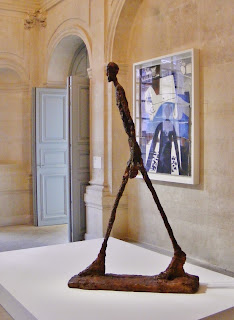 |
| Left, Picasso's Pregnant Woman (1959); right, Giacometti's Tall Woman (1958) |
 |
| Bruno (Picasso, 1920) |
So when I heard the Picasso Museum in Paris was having a show with Giacometti in it, I decided to go back there. Besides, they’ve remodeled since the ouster of the old curator... or so I’m told.
 |
| Ottilia (Giacometti, 1925) |
The artwork - over 200 pieces in all* - starts with early paintings and sculptures by both. The first room includes Picasso’s “The Barefoot Girl” along with Giacometti’s “Still Life with Apples”, both painted when the artists were just 14 years old. Their talent was already obvious.
 |
| Braque on his deathbed (Giacometti, 1963) |
 |
| Goat, Picasso 1950 |
 |
| The dog, Giacometti 1951 |
The final section focuses on their Muses: Annette for Giacometti and mainly Dora Maar for Picasso.

Throughout the exhibit, there were people sketching, including an entire art class.
In addition to the artworks, two films are also on the menu. On the upstairs level, which you reach by a majestic fer forgé and stone staircase, a small room - divided in half by a white wall - projects two films back-to-back.
Facing the window is the 1955 documentary “Le Mystère Picasso” by Henri-George Clouzot in which Picasso sketches himself. It’s fascinating to watch an invisible hand draw one single line that twists and turns until a whole scene emerges, a scene an invisible brush then fills in with shades of black. The mastery of seemingly seeing what is hidden within the blank canvas is amazing. Picasso’s hand never hesitates.On the other side of the partition you can see another documentary, “Alberto Giacometti” by Ernst Scheidegger... or rather a series of short snippets that Scheidegger filmed of his friend between 1961 and 1965. One has him sculpting a face that becomes more and more furrowed with every incision; another shows him sketching Stravinsky.
 |
| Woman sitting (Giacometti, 1958) |
The museum itself is worth the trip. It’s housed in the Hôtel Salé, one of the hôtels particuliers - or private mansions - built in the 17th century in what had been a swamp (thus the name, the Marais).
The whole neighborhood is filled with such mansions. Over the centuries, these majestic houses owned by nobles were broken up into apartments, first by floor and then even more, until they were often just an amalgam of rented rooms. The area slipped down the social ladder, eventually becoming the Jewish ghetto. And then came World War II. The Jews were sent off to camps, most never to return, and the apartments were bought up by good French stock (and yes, that’s irony, because often they were awarded to the people who denounced those Jews).
 |
| Bust of Annette (Giacometti, 1964) |
Other apartments became the property of the City of Paris, often to pay off back taxes. The Hôtel Salé was confiscated in 1962 by the City, the owner and tenants expropriated, to create a Museum of Fashion (which you can now find at the Palais Galliera across town).
 Then in 1974, as per the artist’s wishes, Picasso’s heirs donated all these works of his - over 5,000 of them - and the Musée Picasso was born.
Then in 1974, as per the artist’s wishes, Picasso’s heirs donated all these works of his - over 5,000 of them - and the Musée Picasso was born.* The Giacometti works are on loan from the Fondation Giacometti.

Musée Picasso
4 rue de Thorigny; Paris 3è
01.85.56.00.36
Metro: Filles du Calvaire or Saint-Paul
Open 10:30- 6. Closed Mondays.
To Feb. 15, 2016
12.50€ & 11€
http://www.museepicassoparis.fr/en/picasso-giacometti-3/


No comments:
Post a Comment